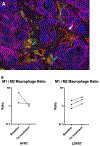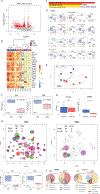A Randomized Trial of Combined PD-L1 and CTLA-4 Inhibition with Targeted Low-Dose or Hypofractionated Radiation for Patients with Metastatic Colorectal Cancer
- PMID: 33568343
- PMCID: PMC8102320
- DOI: 10.1158/1078-0432.CCR-20-4632
A Randomized Trial of Combined PD-L1 and CTLA-4 Inhibition with Targeted Low-Dose or Hypofractionated Radiation for Patients with Metastatic Colorectal Cancer
Erratum in
-
Correction: A Randomized Trial of Combined PD-L1 and CTLA-4 Inhibition with Targeted Low-dose or Hypofractionated Radiation for Patients with Metastatic Colorectal Cancer.Clin Cancer Res. 2021 Sep 1;27(17):4940. doi: 10.1158/1078-0432.CCR-21-2698. Clin Cancer Res. 2021. PMID: 34470811 No abstract available.
Abstract
Purpose: Prospective human data are lacking regarding safety, efficacy, and immunologic impacts of different radiation doses administered with combined PD-L1/CTLA-4 blockade.
Patients and methods: We performed a multicenter phase II study randomly assigning patients with metastatic microsatellite stable colorectal cancer to repeated low-dose fractionated radiation (LDFRT) or hypofractionated radiation (HFRT) with PD-L1/CTLA-4 inhibition. The primary endpoint was response outside the radiation field. Correlative samples were analyzed using multiplex immunofluorescence (IF), IHC, RNA/T-cell receptor (TCR) sequencing, cytometry by time-of-flight (CyTOF), and Olink.
Results: Eighteen patients were evaluable for response. Median lines of prior therapy were four (range, 1-7). Sixteen patients demonstrated toxicity potentially related to treatment (84%), and 8 patients had grade 3-4 toxicity (42%). Best response was stable disease in 1 patient with out-of-field tumor shrinkage. Median overall survival was 3.8 months (90% confidence interval, 2.3-5.7 months). Correlative IF and RNA sequencing (RNA-seq) revealed increased infiltration of CD8+ and CD8+/PD-1+/Ki-67+ T cells in the radiation field after HFRT. LDFRT increased foci of micronuclei/primary nuclear rupture in two subjects. CyTOF and RNA-seq demonstrated significant declines in multiple circulating immune populations, particularly in patients receiving HFRT. TCR sequencing revealed treatment-associated changes in T-cell repertoire in the tumor and peripheral blood.
Conclusions: We demonstrate the feasibility and safety of adding LDFRT and HFRT to PD-L1/CTLA-4 blockade. Although the best response of stable disease does not support the use of concurrent PD-L1/CTLA-4 inhibition with HFRT or LDFRT in this population, biomarkers provide support that both LDFRT and HFRT impact the local immune microenvironment and systemic immunogenicity that can help guide future studies.
©2021 American Association for Cancer Research.
Figures





References
-
- Overman MJ, McDermott R, Leach JL, Lonardi S, Lenz HJ, Morse MA, et al. Nivolumab in patients with metastatic DNA mismatch repair-deficient or microsatellite instability-high colorectal cancer (CheckMate 142): an open-label, multicentre, phase 2 study. The Lancet Oncology 2017;18(9):1182–91 doi 10.1016/S1470-2045(17)30422-9. - DOI - PMC - PubMed
-
- Dewan MZ, Galloway AE, Kawashima N, Dewyngaert JK, Babb JS, Formenti SC, et al. Fractionated but not single-dose radiotherapy induces an immune-mediated abscopal effect when combined with anti-CTLA-4 antibody. Clinical cancer research : an official journal of the American Association for Cancer Research 2009;15(17):5379–88 doi 10.1158/1078-0432.CCR-09-0265. - DOI - PMC - PubMed
Publication types
MeSH terms
Substances
Grants and funding
LinkOut - more resources
Full Text Sources
Other Literature Sources
Medical
Research Materials
Miscellaneous

